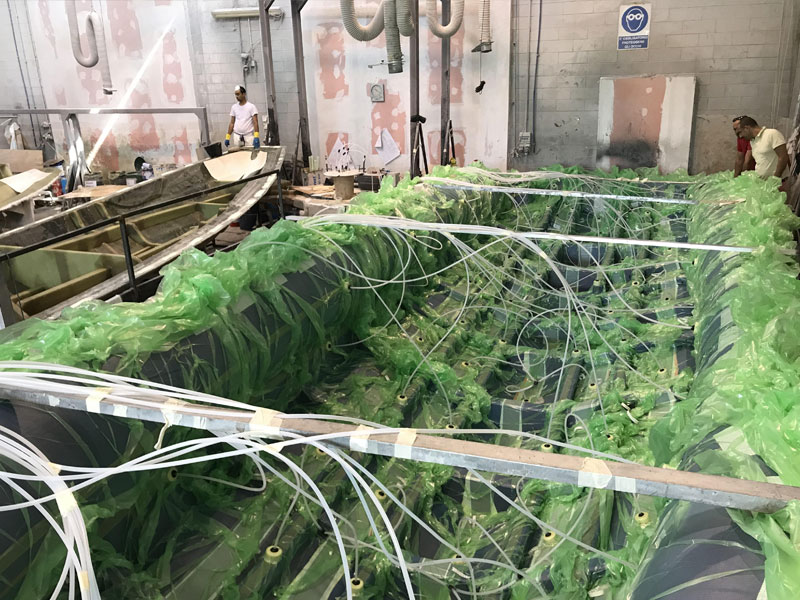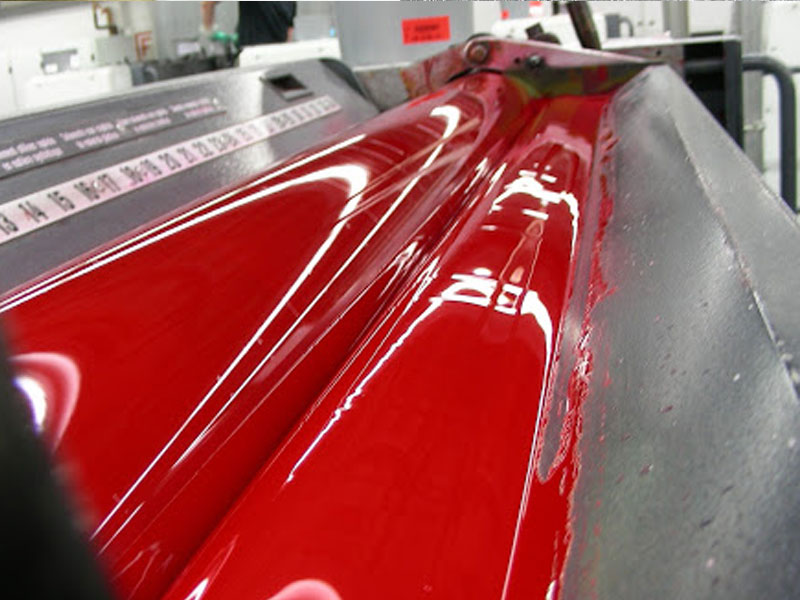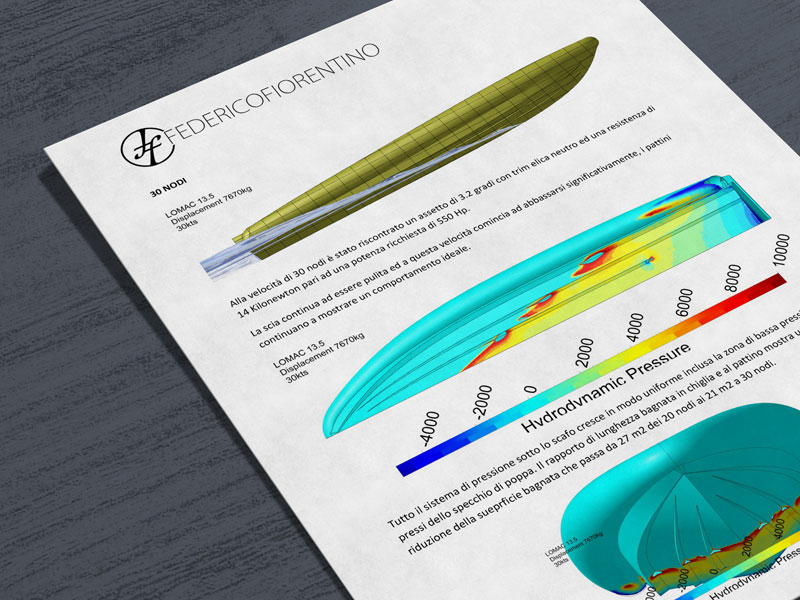Know how
- Vacuum infusion lamination
- Vinyl-ester and isophthalic resin
- Neopentyl gelcoat and barrier coat
- Multiaxial fabrics
- In-house engineering and technical office
- CFD (Computational Fluid Dynamics) modeling
- “Made in Milan” design by Federico Fiorentino (luxury yachting & racing)
- Performance, safety and seaworthiness
Vacuum infusion lamination
Lomac’s best-of-breed boats are built using advanced resin coating techniques and innovative materials. The method chosen for hull construction is vacuum infusion stratification, recognised as the best solution for fiberglass hulls and used today at top shipyards around the world.
Yachts built using this method offer clear benefits. First, they are lighter and stronger, because the fiber to resin ratio is perfectly balanced and constant everywhere. In fact, one of the main problems of manual stratification is that it depends on operators’ manual skills and the force they apply to the roller when spreading the resin and impregnating the fiber. It is natural that during the working day, due to fatigue or other factors, there may be variations and therefore unevenness in the end product, resulting in weaker areas that are impossible to identify, assess and correct before they become apparent because of an impact or in the form of spontaneous delamination.
Another important benefit of vacuum technology is that it significantly reduces emissions of styrene (a liquid aromatic hydrocarbon that is toxic for workers and the environment), resulting in a workplace that is healthier and more environment-friendly.

Vinyl-ester and Isophthalic Resin
Another important feature of Lomac hulls is the use of vinyl-ester resin, which has excellent mechanical strength, comparable with epoxy resins, and a heat distortion temperature of over 110°C. Its characteristics and ease of use, comparable with a polyester, mean that vinyl-ester resin is used to produce composites for heavy duty applications with both fiberglass and high modulus fibers like carbon and Kevlar. This is the resin used to make, among other things, motorcycle silencers, shells, fairings, heat resistant components, racing boats, etc. Vinyl-ester resin also has excellent resistance to aggressive chemicals and concentrated acids and is therefore also used for fiberglass structural anticorrosion coatings.
Neopentyl gel-coat and barrier-coat

There has also been a special focus on the gelcoat, which in recent years has been the main cause of osmosis and/or the rapid ageing of surfaces in contact with the water. That is why it has been decided to use what is regarded today as the ultimate polyester gelcoat. Used in the shipbuilding industry for large boats in the 15 to 30 meter range and racing boats, neopentyl gelcoat guarantees maximum resistance to UV rays, high gloss and no yellowing for many years. The perfectly water-impermeable hull and deck guarantee better resistance to osmosis and very high chemical resistance. Neopentyl gelcoat is also used in the construction of racing car bodies and accessories.
No less important are the benefits of using a barrier coat sprayed directly onto the gelcoat. It offers an innovative and rapid solution to the problem of fiberglass marking on the gelcoat, as well as reducing the risk of microbubble formation and acting as a barrier to osmotic processes. The quality of the end product also benefits from the strength of the gelcoat, which cures in airtight conditions because it is covered and protected by the barrier coat. Its natural resistance to aggressive chemicals and the “buffer” effect generated by the hollow, flexible microspheres it contains make it possible to produce stratified materials with excellent structural properties.
These are the reasons that have convinced Lomac to use barrier coat, which is becoming increasingly popular in the production of high quality rib and in mould making. In the final analysis, its use improves surface quality, which guards against osmosis-derived deterioration phenomena, improves the gelcoat curing process, increasing hardness, and protects against fiberglass marking caused by resin shrinkage.
Multiaxial fabrics
Now let’s look at the main body of the product and the fabrics used for its construction. The choice of multiaxial fabrics was almost obligatory, as well as offering the best solution to deliver optimum structural characteristics. Over the last decade, we have seen the emergence of a new category of reinforcement fabrics known as multiaxials. These aren’t in fact real fabrics, even though this is the commonly used term, and they don’t have warp and weft fibers at 0/90°. Multiaxial fabrics create a reinforcement that is “quasi isotropic”, or in other words one that is equally strong in every direction.
Another benefit over loom-woven fabrics is that the fibers in multiaxial fabrics are all aligned and uniformly tensioned, and therefore ready for load bearing without any loss of strength before they tense. The absence of movement between the fibers (at the points where they cross in fabrics) improves their performance under stress, because the load is distributed over the entire length of the fiber and not concentrated in the critical nodal points. This means that the fibers in the fabric withstand higher loads than aligned fibers, which translates into greater resistance to fatigue and stress. Multiaxials make it possible to reduce the thickness and therefore the weight of the stratified material, while offering the same strength.

In-house engineering
The Engineering department, with the Technical Office, drives technological innovation at Lomac. This in-house center of excellence is equipped with cutting edge technology and specialises in the design and development of new models and research into new materials. The department is organised into technology areas dedicated to specific aspects of production: Hull Design, Electronic Instrumentation, VTR Structures and Composition, Technical Systems and Electrical Systems, Manuals and Certifications. Close collaboration between the Engineering department and technology partners, particularly for engines, has led to the development of increasingly innovative, high performance and personalised systems.
CFD modeling

Computational Fluid Dynamics (CFD) uses numerical analysis and algorithms to solve and analyse fluid dynamics problems with the help of dedicated software. All Lomac’s top-of-the-range hulls have been developed using this technology, which translates into the performance, handling and seaworthiness that sets Lomac apart. Tests have been performed in all conditions to optimise not only speed, but also efficiency and consumption. All this ensures that control and safety are an intrinsic part of the performance that gives our customers the carefree excitement they desire.

